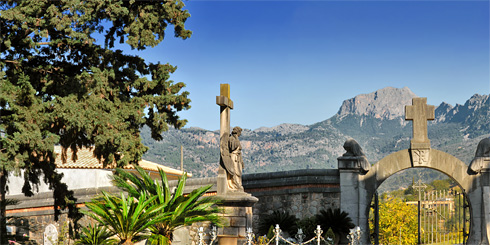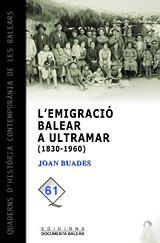Returning migrants and their legacy
"Wanted: Men of 12 to 40 years of age, willing to leave home and seek their fortune in the New World. They are assured a sea crossing of at least a month in pitiful conditions; a working day of 15 to 18 hours with no day off; many years of austerity, scrimping and saving; endemic illnesses; heat and tropical rain; no guaranteed return and doubtful success; but if they make it: prosperity and an honourable return to their native land"
The tenacious, entrepreneurial workers sought by this fictitious advert correspond to almost fifty million Europeans who migrated to other continents during the big migrations that took place between the mid and late 19th century. America, Asia and Australia offered these people the chance to colonize land and take advantage of their abundant resources.
Spain and the Balearics were also affected by the phenomenon. Given their insular nature, in the word of writer Alejo Carpentier, the Balearic Islands were "...a place without roads to other lands that could be reached on wheels, horseback or on foot, by crossing over frontiers".
Thus it was that thousands of Mallorcans set sail between the late 19th and early 20th centuries for America, the Philippines, France or Algeria, fleeing a life of deprivation in the unproductive agricultural or craftwork sectors, where they had no opportunity of rising up the social ranks. In addition, youths under the age of 17 could thus escape the long military service that they were forced to do in Spain and the wars in which the country was immersed.
Boys and young men from all over the Serra de Tramuntana set off on this migratory quest in a bid to improve their fortune, with a few dozen leaving from hamlets like Galilea or Es Capdellà and hundreds or thousands from municipalities with bigger populations (Sóller, Pollença or Andratx). They did not embark on a reckless adventure, since they always had some kind of relative or friend in the host country. Previous migrants offered their relatives or fellow countrymen work, helping out with the initial journey and accommodation. The ‘chosen ones’ started out working as general dogsbodies in exchange for food and lodging in family businesses like fruit shops, bakeries, restaurants, shoe-making workshops, or printing presses.
Cuba, Argentina, Puerto Rico, Uruguay and Chile were the main South American destinations for emigrants from Mallorca. Many of them returned after a few years. With much scrimping and scraping, they managed to save up the cost of a return ticket. A minority, however, triumphed, setting up lasting businesses and companies. From among these fortunate few, some stayed in their adoptive country until they died, while others, longing to return, finally made it back to their towns or villages, loaded with all kinds of luxuries.
Within Europe, many people from Sóller and S’Arracó chose France as the place to set up a business or make their dream come true. Often they started out as travelling salesmen, selling fruit or food, going on to have stable, prosperous businesses, like the Au Jardin d’Espagne fruit shops that could be found throughout France, or cafés, food shops, wineries and restaurants. In 1887, there were 43 restaurants in Marseille run by people from Sóller.
When these entrepreneurs were relatively well off, it was typical for them to seek a wife back home from their town or village, although many weddings had to be celebrated by power of attorney. These emigrants liked to keep in contact with their place of birth, as it fuelled their desire to return there one day. When the moment arrived, however, they did not return as that young nobody who had left years before, but as a rich emigrant who had climbed to the top of the social scale and who devoted part of his fortune to philanthropic activities.
Returning emigrants used Gallicisms or South Americanisms when they spoke and they had a foreign accent. They stood out for their white clothes, Panama hat, and waistcoat with a thick gold chain across it, complete with a pocket watch. They would also wear a ruby ring on their ring finger.
As status symbols, they built splendid colonial-style or Modernist mansions (since this was the art movement in vogue at the time), reflected by the buildings’ façades, galleries, vantage points, towers, domes, stairways and all kinds of magnificent finer details. These elegant hitherto unseen mansions also featured the latest innovations, hot water, a bathroom and a fitted kitchen. In the garden, decorated with pergolas, fountains, columns and benches, tropical trees were planted, like persimmons, jacarandas, ombu trees, araucarias and, needless to say, fan palms, proclaiming that their owner had once lived in foreign lands. Almost all the towns and villages in the Serra have mansions of this kind: Can Maçana, Can Querol and Can Prunera in Sóller, Villa Francisca in Bunyola, and Ca na Torretes in s’Arracó, among many others.

Molts indians volgueren també deixar la seva empremta a través de monuments fúnebres i encarregaren les tombes i panteons familiars a escultors o artistes funeraris. Al cementeri de Sóller n'hi ha algunes bones mostres.
Many such people also wished to make their mark by leaving behind burial monuments, and they commissioned sculptors or stone workers with graves and family mausoleums. In Sóller cemetery, numerous good examples can be seen. Today, there are thousands of descendents of Mallorcan emigrants and they are fortunate to be able to count on new technologies. Internet serves as a forum for them, and you can come across historians researching emigrants from their hometown to America or France, or else wishing to make contact with original emigrants or their families.
Text by Elena Ortega
Translated by Rachel Waters
Did you know that...
Joan Canyelles Sastre, known by the nickname Pereó, was a native of Selva who emigrated to America in the early 20th century. He settled in Montevideo, where he opened a shoe shop, married and had three children. Forty years later, he returned alone. Wishing to be remembered by his fellow townsmen, he donated a bench to the town. When Pereó died, his children decided to come to Mallorca and sell the Selva bank that their father had so often talked about.
Their taxi stopped at the entrance to the town so they could ask some elderly townsfolk, sitting in the shade chatting, where Joan Canyelles’ bank was. They were astounded when the townsfolk stood up from the stone bench and showed them the inscription carved on the back, 'Courtesy of Joan Canyelles for his fellow compatriots'. (From L'herència de l'indià by Pere Morey).
Bibliography

Buades, J. L’emigració balear a ultramar (1830-1960). Edicions Documenta Balear, 2009.
Ferrà, D. Emigració dels campaneters a Europa. Fundació Balears a l’Exterior, 2010.
Jofre, A. Migraciones entre Argentina y Mallorca: dos caras de un mismo fenómeno. Fundación Cátedra Iberoamericana, 2004.
Melero, L. Indianos, una forma de heroismo. El Cobre Ediciones, 2007.
Quetglas, A. "Les conseqüències culturals i socials de l’emigració a França. El cas de Sóller (1880-1936)". Cercles. Revista d’història cultural, January 2008.
Serra, S. L’emigració de les Illes Balears a Amèrica. Institut d’Estudis Baleàrics, 2002.
Vicens, A. Sollerics a França. Passions i quimeres. 1870-1940. El Tall editorial, 1993.




